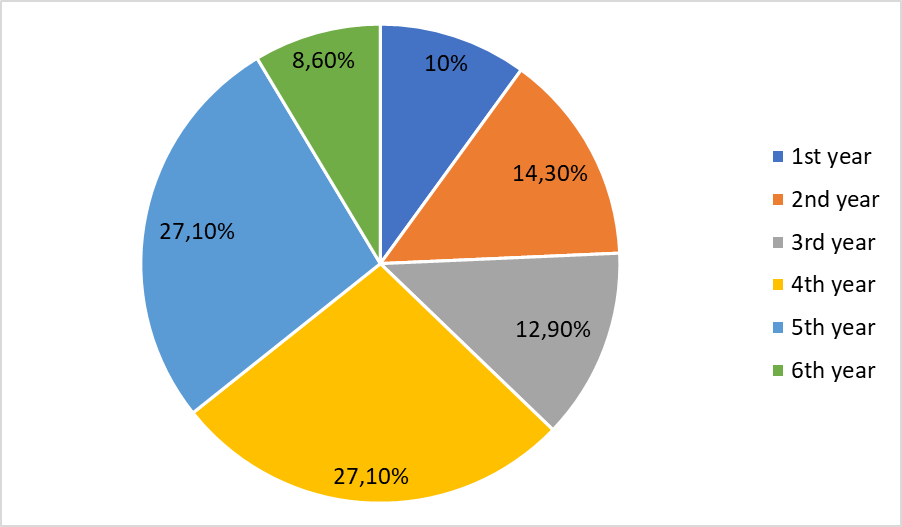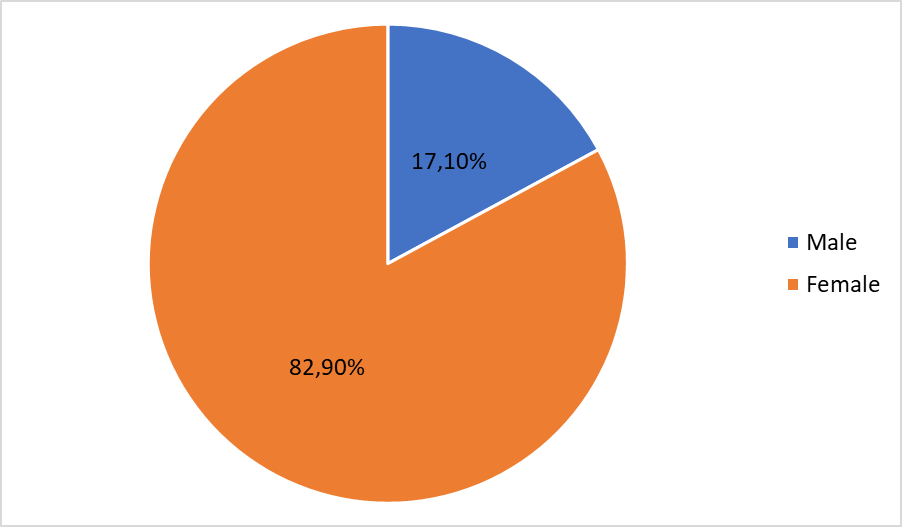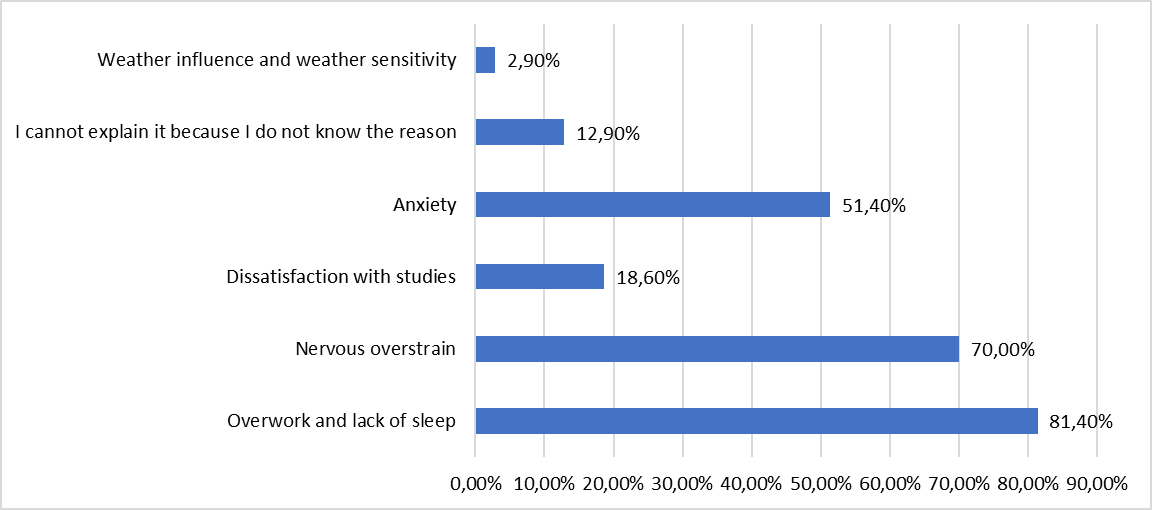Etiological Aspects of the Primary Headache Prevalence: on the example of PSMU (Pacific State Medical University) students
Etiological Aspects of the Primary Headache Prevalence: on the example of PSMU (Pacific State Medical University) students
Abstract
The article is devoted to the analysis of the spread, identification and evaluation with the help of a questionnaire, created in an online Google Form, for primary headaches (tension headaches and migraines) among medical students of PSMU (Pacific State Medical University) both of the 1st and subsequent years, up to the 6th. This has made it possible to identify multidirectional indicators of detection between the form of headaches and the year of studying. The analysis of the survey made it possible to identify the primary psychosocial factors affecting the development of tension headaches and migraines, which in 70% of cases is associated with nervous overstrain, in 51.4% of cases with anxiety and in 18.6% with dissatisfaction with studies, to analyze the causal occurrence mechanisms for such aches and consider their impact on the students' daily life quality.
1. Introduction
Among the pain sensations of various localization, headache is far from the last place – a feeling of pain in the area of the cerebral or facial part of the head that occurs in various pathological conditions of the body. In the practice of pain treatment, therapists and neurologists often meet with headache syndrome (HS).
According to statistics, almost 90% of humanity experience headaches, noting that every fifth person has a decrease in working capacity against this background , . At the same time, working capacity, quality of life and the learning process decrease, which is especially important for medical university students . Epidemiological studies of primary headaches in students in various countries have shown a high prevalence of headaches (migraines – from 11% to 40%; tension headaches (TH) – from 5.6 to 40.8%) .
The purpose of the study: to determine the prevalence and main causes of primary headaches among medical students of PSMU.
2. Materials and methods
The present study included an anonymous on-line survey, created in Google Form, for students of the Pacific State Medical University enrolled in higher education programs from 1st to 6th years (Table 1).
The survey was conducted using a test questionnaire developed by us, which includes 16 questions.
Table 1 - Questionnaire
N i/t | Question | Variant of answer |
1 | What course are you a student of | 1 / 2 / 3 / 4 / 5 / 6 |
2 | Your gender | Male / Female |
3 | How often do you have a headache | 1 time per month / Up to 7 times a month / Up to 15 times a month / More than 15 times a month |
4 | The duration of your headache | From 30 min. to 7 days / From 4 hours to 72 hours |
5 | Do your relatives have headaches | Yes / No |
6 | How do you stop a headache | Medically / Non-medicated |
7 | Psychological stress causes (increases) headache | Yes / No |
8 | Do you have harbingers of a headache | Yes / No |
9 | Concomitant headache symptoms | • Nausea • Vomiting • Photophobia • Sounds phobia • Muscle tension of the neck, shoulder or back of the head • There is nothing like that |
10 | Localization of headache | One-sided / Two-sided by the type of "hoop" |
11 | The nature of the headache | Pulsating / Compressive |
12 | Physical activity led to | Strengthening HS / Lightening HS / Did not affect HS |
13 | The effect of headache on daily activities | Affects / Does not affect |
14 | A headache attack occurs after | • Overwork • Lack of sleep • Nervous overstrain • Physical overstrain • Consumption of certain foods • I do not explain in any way, because I do not know the reasons • Other |
15 | Does the training load affect the frequency of headaches | Yes / No |
16 | Did the frequency and intensity of headaches increase during distance learning | Yes / No |
The study included questionnaires of 70 students, among whom the proportion of 1st-year students was 10% (n = 7), 2nd-year students – 14.3% (n = 10), 3rd-year students – 12.9% (n = 9), 4th-year students – 27.1% (n = 19), 5th-year students – 27.1% (n = 19) and 6th-year students – 8.6% (N = 6) (Fig. 1).

Figure 1 - Participants of online survey-questionnaires depending on the year of studying

Figure 2 - The ratio of medical students who took part in the survey by gender
3. Results and discussions
Analysis of the survey data revealed that tension headaches (TH) are quite common among PSMU students both in the 1st and subsequent years, up to the 6th (67.1%). Migraines among the respondents were observed in 14.3% of students, with a predominance in the 1st and 6th years. Mixed primary headaches (combination of migraine with TH) were observed in 18.6% of respondents, with unidirectional spread from 1st to 6th year (Table 2).
Table 2 - Prevalence of primary headaches in students
Prevalence among PSMU students
| Primary headaches (GB) | ||
Tension Headaches (TH) | Migraines | Mixed primary headaches | |
1st year | +++ | +++ | + |
2nd year | +++ | + | + |
3rd year | +++ | + | + |
4th year | +++ | + | + |
5th year | +++ | + | + |
6th year | +++ | +++ | + |
Result, % | 67.1 | 14.3 | 18.6 |
4. Research results
The analysis of the survey data made it possible to determine the primary psychosocial factors affecting the development of tension headaches and migraines in students. At the same time, 81.4% of respondents identified overwork and inadequate sleep or lack thereof among the main causes (n = 57), in 70% of cases the main cause is nervous overstrain (n = 49), in 51.4% of cases anxiety (n = 36), in 18.6% dissatisfaction with studies was the main cause of migraine (n = 13), 2.9% noted the influence of weather and meteosensitivity (n = 2) and 12.9% of respondents could not explain the cause of their headaches (n = 9) (Fig. 3).

Figure 3 - Psychosocial factors influencing the development of tension headaches and migraines in medical students of PSMU
5. Results
The data obtained confirm the fact that the prevalence of primary headaches among students of PSMU is quite high. First of all, this is due to the influence of the main psycho-emotional factors: overwork, lack of sleep, stress, maximum psycho-emotional and intellectual loads, especially during the period of taking tests and exams. Of particular importance is the activation of the trigemin-vascular system and the "triggering" of a migraine attack by trigger factors, which contributes to an increase in the sensitivity (sensitization) of trigemin-vascular fibers, as well as an increase in the excitability of the cerebral cortex. This corresponds to the neurogenic concept, where the leading role in the development of migraine belongs to the dysfunction of the central, peripheral and autonomic links of the nervous system.
The data obtained by us correspond to the literature data and are of a medical and social nature, since they directly affect the student's academic performance and performance during the study period.
The "muscle factor" and emotional stress are the main provocateurs of HS, causing and increasing the sensitivity and soreness of the muscles of the head and neck, which requires preventive measures aimed at rational provision of work and rest . Among which compliance is highly important:
1. Sleep and wakefulness, because full sleep at night and short-term daytime sleep, contribute to the effective assimilation of educational material and ensure the process of transferring information from RAM to long-term memory;
2. The organization of a complete and balanced protein, vitamins and vegetable fats, at least 4-5 times a day;
3. Alternating the load with the optimal form of its distribution every 1.5 hours of classes, perform simple physical exercises, because prolonged sedentary mental work disrupts lymph circulation and outflow, which contributes to the formation of insufficiency in these body systems in the future;
4. Stay more outdoors, contributing to the saturation of the body with oxygen.
6. Conclusion
Headaches are one of the most common complaints among students of PSMU of different years, among which tension headaches (TH) are the most widespread, which is due to the influence of such primary psychoemotional factors as fatigue, lack of sleep, stress, maximum psychoemotional and intellectual loads during the adaptation period for first-year students and passing tests and exams for all students. In this regard, students were offered various preventive measures to ensure the organization of a rational work and rest regime.
